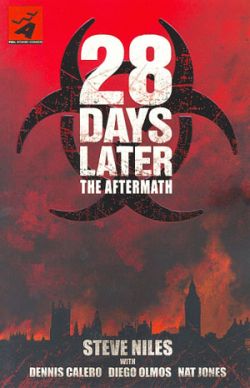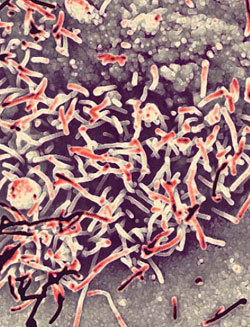- Comics
- Comics Reviews
- Manga
- Comics Reviews
- European Comics
- News
- Comics News
- Press Releases
- Columns
- Spotlight
- Digital Comics
- Webcomics
- Cult Favorite
- Back Issues
- Webcomics
- Movies
- Toys
- Store
- More
- About
By Al Kratina
May 17, 2007 - 10:14
 |
I was six years old when I stopped letting my mother hold my hand when I crossed the street. So, I don’t see why I would let Steven Niles hold my hand now, when I’m in my twenties and trying to navigate my way between 28 Days and 28 Weeks Later. I can get from one to the other on my own, thank you very much, without a stop-gap graphic novel to fill in the blanks, plus judging from 30 Days Of Night, Batman: Gotham County Line, and the other creepy horror stories Niles has told in the past, his hand is probably all cold and clammy anyway.

The Ebola virus, painted red to look more like the rage in 28 Days Later.
28 Days Later: The Aftermath is a capably executed but wholly unnecessary expansion on the world created by Danny Boyle’s 2002 film. Broken into four chapters, Development, Outbreak, Decimation, and Quarantine, the novel charts the rage virus from its inception to its apparent demise, setting the stage for the theatrical release of 28 Weeks Later. The first chapter, Development, is the most successful of the four. Two scientists, one driven by an unhealthy ambition and the other possessed of a dangerous temper, attempt to develop an anger inhibitor for use on the general population. Illegal experiments on humans result in failure, and they revert to using monkeys, indicating that they’ve apparently educated themselves by watching mad scientist films in reverse. While some of the characterization in this story is very interesting, particularly that of the young, rage-prone scientist Clive, the sense of mystery regarding the true origins of the virus is somewhat spoiled by the revelations in this chapter. As well, the hints of a shadowy conspiracy behind the research, and the amorality of some of the characters reduces a complex story line to a simple good vs. evil theme: while they were initially trying to cure anger, these scientists are bad people, so they did a bad thing. However, despite those complaints, Niles’ characters and dialogue, buoyed by the rich, detailed, and realistic art of Dennis Calero, make the first chapter a solid read.
The second chapter, Outbreak, is the weakest of the four. Immediately after an infected monkey’s escape from the research lab, a family on picnic is forced to defend itself from infected humans infesting Cambridge. While Niles’ dialogue really shines here, especially in an exchange between the blue collar father and his goth punk son, the presence of the actual monkey running around biting people is somewhat silly. It’s not helped by Diego Olmos and Ken Branch’s colorful and simplistic art, which makes the whole thing look like a Saturday morning cartoon with rabies. Still, there are some nice moments, and it has an ending that, like most zombie films, is simultaneously grim and hopeful.

The monkey from Outbreak, which should be required watching for all mad scientists.
In Decimation, the third chapter, London is empty and abandoned, over-run by starving infected. Dressed up like Rambo outfitted from a hockey rink locker room, a lone man holds his own against the teeming infected. Until, that is, he comes across another solitary Sports Experts commando. Instead of helping each other survive the plague, they immediately launch into a mutual attack, and become more interested in killing each other than anything else. Despite the collapse of the world around them, they’re still filled with aggression and pride, completely blind to the irony. Thematically, this is the most interesting of the stories, but while Nat Jones’ shambling infected bring to mind Bernie Wrightson-esque corpses, some of the panel layouts are confusing, and ultimately it comes off too much like a zombie movie instead of the sci-fi thriller the film was.
The last story, Quarantine, brings back Calero’s excellent artwork, but it’s still a disappointing chapter. Not because of any failing in the dialogue, which is realistic and strong throughout, but because it brings together characters from the three previous chapters. One of the most horrifying things about these sorts of apocalyptic films is their grand scope, which this sort of tying together of loose ends eliminates and trivializes. Instead of seeing what happens when a country collapses, we’re witnessing the death of the cast of Friends, or some other cast of characters. Still, there are some nice touches on the whole, and while this graphic novel is completely unnecessary, if you really need someone to hold your hand, Niles is probably the man to do it.
Rating: 6 /10